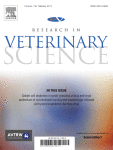View Item
- xmlui.general.dspace_homeCentros Regionales y EEAsCentro Regional Patagonia NorteEEA BarilocheArtículos científicosxmlui.ArtifactBrowser.ItemViewer.trail
- DSpace Home
- Centros Regionales y EEAs
- Centro Regional Patagonia Norte
- EEA Bariloche
- Artículos científicos
- View Item
Identification of Corynebacterium pseudotuberculosis from sheep by PCR-restriction analysis using the RNA polymerase β-subunit gene (rpoB)
Abstract
Caseous lymphadenitis, caused by Corynebacterium pseudotuberculosis, has a high prevalence in many regions of the world, including Argentina and Brazil. A polymerase chain reaction–restriction fragment length polymorphism (PCR–RFLP) method for the identification of this microorganism was designed based on the hypervariable region of the polymorphic RNA polymerase b-subunit gene (rpoB). All available Corynebacterium rpoB sequences were analyzed by
[ver mas...]
Caseous lymphadenitis, caused by Corynebacterium pseudotuberculosis, has a high prevalence in many regions of the world, including Argentina and Brazil. A polymerase chain reaction–restriction fragment length polymorphism (PCR–RFLP) method for the identification of this microorganism was designed based on the hypervariable region of the polymorphic RNA polymerase b-subunit gene (rpoB). All available Corynebacterium rpoB sequences were analyzed by computer-assisted restriction analysis. The rpoB
PCR–RFLP pattern predicted by using endonucleases MseI and StuI clearly differentiated C. pseudotuberculosis from sixty-one other Corynebacterium species. This method was successfully applied to identify twelve wild C. pseudotuberculosis ovine isolates and one caprine isolate. It was also used to differentiate C. pseudotuberculosis from Arcanobacterium pyogenes, an ovine pathogen with similar clinical characteristics. These results indicate that this new molecular method can be used for the reliable identification of
the pathogen, essential for the timely detection of infected animals and for epidemiological studies.
[Cerrar]

Author
Pavan, María Elisa;
Robles, Carlos Alejandro;
Cairó, Fabián A.;
Marcellino, Romanela;
Pettinari, María Julia;
Fuente
Research in Veterinary Science 92 : 202–206 (2012)
Date
2012-04
Editorial
Elsevier
ISSN
0034-5288
Formato
pdf
Tipo de documento
artículo
Palabras Claves
Derechos de acceso
Restringido
 Excepto donde se diga explicitamente, este item se publica bajo la siguiente descripción: Creative Commons Attribution-NonCommercial-ShareAlike 2.5 Unported (CC BY-NC-SA 2.5)
Excepto donde se diga explicitamente, este item se publica bajo la siguiente descripción: Creative Commons Attribution-NonCommercial-ShareAlike 2.5 Unported (CC BY-NC-SA 2.5)

